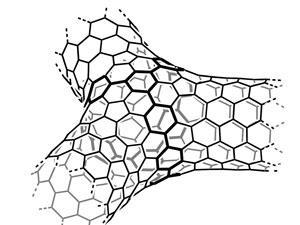Scientists have made a uniform junction unit for branched carbon nanotubes

In a bid to make structurally uniform carbon nanotubes for applications in optoelectronics, for example, and following on from work done to make uniform carbon nanoring sidewalls, scientists in Japan have now made a uniform junction unit for branched carbon nanotubes.
The junction is a strained, conjugated carbon nanocage. Strained cages are rare and forming strained hydrocarbon cages consisting of sp2 and/or sp-hybridised carbons such as this is a formidable task, said the researchers.
Kenichiro Itami from Nagoya University, and colleagues, made their all-benzene nanocage because branched nanotubes are attracting attention as potential small logic gates or transistors.
The team started with an assembly of cyclohexane-based L-shaped units and benzene-based three-way units by cross-coupling and homocoupling to give an unstrained cyclic precursor. Then, they converted this into the strained nanocage by acid-mediated aromatisation.
Physical studies on the cage revealed a high fluorescence quantum yield (efficiency of fluorescence; ratio of the number of photons emitted to the number of photons absorbed) and a relatively large two-photon absorption cross section (an optical process in which two photons of identical or different frequencies are absorbed to excite a molecule from one state, usually the ground state, to a higher energy electronic state).
Itami’s team now plans to explore applications for the nanocage, such as in optoelectronics and host–guest chemistry. ‘We are now in a position to initiate the bottom-up synthesis of branched carbon nanotubes using the junction unit and a sidewall unit as key components,’ they said.






No comments yet